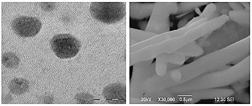Home > Press > Controlling Shape of Lead Nanoparticles by Sunlight: Indian researchers explore sunbeams as morphological changer of nanomaerials
 |
| TEM Image: Pb Nanospherical SEM Image: Rod Shape changed by Sunlight |
Abstract:
Indian researchers (Theivasanthi and Alagar) have controlled shape of lead nanoparticles by using sunbeams. They have explored sunbeams as morphological changer of nanomaerials The group, based at Centre for Research and Post Graduate Department of Physics, Ayya Nadar Janaki Ammal College comments: 典o our best knowledge, this is the first demonstration for controlling shape of lead nanopowder (Pb) under the influence of sunbeams.
Controlling Shape of Lead Nanoparticles by Sunlight: Indian researchers explore sunbeams as morphological changer of nanomaerials
India | Posted on April 11th, 2013The researchers have explained the detailed procedures in their recent report [Theivasanthi et al, nanobe.org/Pb nanorods ]. goo.gl/sIIuK . They have synthesized Pb spherical nanoparticles by electrolysis method using a bioactive compound - konjac (Amorphophallus Paeoniifolius) aqueous extract and such a procedure has so far not been used for nanoparticles preparation. This nanomaterial has potential applications in lead batteries, catalysis, superconductor and photonic crystal. TEM image confirms the 10 nm size of Pb nano-spherical.
In the report: Size and shape provides important control over many of the properties like physical, chemical and catalytic properties of nanomaterials. When nanomaterials interact with biological systems, their properties are changed significantly, may also be desirable characters in sometimes. While, on contact with a biological fluid they may become coated with proteins and other bio-molecules. Capping agents assisted synthesis methods usually produce spherical particles due to the low surface energy associated with such particles.
The researchers have said that generally, metal nanoparticles strongly absorb light in the visible region due to Surface Plasmon Resonance (SPR) and the absorbed light promotes some reactions on the nanoparticles. "On this basis, an attempt has been made to explore the effects of the sunlight on Pb nanoparticles and to find the possibilities for dual function utilization of sunlight i.e. as a dryer for the synthesized nanomaterials and as a morphological changer. The result explicates that it is possible to change the shape of Pb nanoparticles (konjac extract added) from spherical to rod by the influence of sunbeams", the researchers comment, adding: "Further research work is under process to find the possibility of morphological effect changes by sunlight, in other metal nanoparticles with konjac extract or other bio-molecules".
####
For more information, please click here
Contacts:
T.Theivasanthi
Copyright © Theivasanthi - Nano Researcher
If you have a comment, please Contact us.Issuers of news releases, not 7th Wave, Inc. or Nanotechnology Now, are solely responsible for the accuracy of the content.
| Related News Press |
News and information
![]() Simulating magnetization in a Heisenberg quantum spin chain April 5th, 2024
Simulating magnetization in a Heisenberg quantum spin chain April 5th, 2024
![]() NRL charters Navy’s quantum inertial navigation path to reduce drift April 5th, 2024
NRL charters Navy’s quantum inertial navigation path to reduce drift April 5th, 2024
![]() Discovery points path to flash-like memory for storing qubits: Rice find could hasten development of nonvolatile quantum memory April 5th, 2024
Discovery points path to flash-like memory for storing qubits: Rice find could hasten development of nonvolatile quantum memory April 5th, 2024
Discoveries
![]() Chemical reactions can scramble quantum information as well as black holes April 5th, 2024
Chemical reactions can scramble quantum information as well as black holes April 5th, 2024
![]() New micromaterial releases nanoparticles that selectively destroy cancer cells April 5th, 2024
New micromaterial releases nanoparticles that selectively destroy cancer cells April 5th, 2024
![]() Utilizing palladium for addressing contact issues of buried oxide thin film transistors April 5th, 2024
Utilizing palladium for addressing contact issues of buried oxide thin film transistors April 5th, 2024
Materials/Metamaterials/Magnetoresistance
![]() Nanoscale CL thermometry with lanthanide-doped heavy-metal oxide in TEM March 8th, 2024
Nanoscale CL thermometry with lanthanide-doped heavy-metal oxide in TEM March 8th, 2024
![]() Focused ion beam technology: A single tool for a wide range of applications January 12th, 2024
Focused ion beam technology: A single tool for a wide range of applications January 12th, 2024
Announcements
![]() NRL charters Navy’s quantum inertial navigation path to reduce drift April 5th, 2024
NRL charters Navy’s quantum inertial navigation path to reduce drift April 5th, 2024
![]() Discovery points path to flash-like memory for storing qubits: Rice find could hasten development of nonvolatile quantum memory April 5th, 2024
Discovery points path to flash-like memory for storing qubits: Rice find could hasten development of nonvolatile quantum memory April 5th, 2024
|
|
||
|
|
||
| The latest news from around the world, FREE | ||
|
|
||
|
|
||
| Premium Products | ||
|
|
||
|
Only the news you want to read!
Learn More |
||
|
|
||
|
Full-service, expert consulting
Learn More |
||
|
|
||








